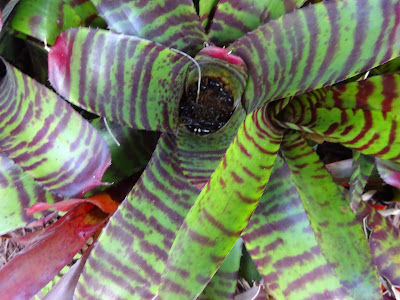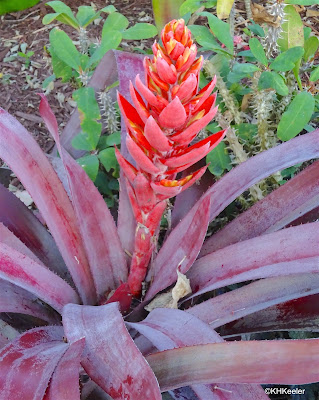Brilliant foliage
And it can be this red in the wild. This very old photo from Costa Rica shows red-leaved bromeliads in the tree
There are other leaf patterns, some surely enhanced by breeders
Flowering stalks are often brightly colored. Immediately below, the actual flowers are small and yellow, inside the big red inflorescence
The red inflorescences are of course very attractive to the humans who put these in their gardens, but they are also attractive to hummingbirds, the most important group of pollinators for these plants of the New World tropics (hummingbirds are New World birds).
Here is how they look in nature, though this one is closer to the ground than most are.
Here are a couple famous bromeliads:
pineapple, Ananas comosus
and Spanish moss. It is neither Spanish, nor a moss, but a bromeliad, Tilandsia usneoides. native all across the Americas but not native to Europe. Its flowers are small and obviously the plant shape is unusual.
 |
| Spanish moss, Tilandsia usneoides |
And, finally, a bromeliad as jewelry. This plant, a Tilandsia I haven't identified, is on a leather cord to be worn as a necklace. I received it as a gift and was horrified; my house's humidity averages about 30% and the winter air temperature is 67, terrible living conditions for a tropical airplant. After a year, I haven't killed it, though you can see browned leaf tips. I mist it most days. I searched my house for a better pot for it, tiny but larger than 1/2" in diameter, but couldn't find one, so it remains growing as a necklace.
Comments and corrections welcome.
Kathy Keeler, A Wandering Botanist
More at awanderingbotanist.com
Join me on Facebook: https://www.facebook.com/AWanderingBotanist















HaHA! You were at my great grandfather's house in Coconut Grove...the tennis court was not there in my day, but I spent the first three years of my life on that property (usually in the pool or the little fountain at the entrance,lol). Hope you enjoyed it as much as I enjoy your writing!
ReplyDelete